Nikolaus A. Otto (1876)
Four-Stroke Engines
Two-Stroke Engines
Two-Stroke Engines
The intake and exhaust valves are replaced by openings in the lower portion of the cylinder wall.
During the latter part of the power stroke, the piston uncovers first the exhaust port, allowing the exhaust gases to be partially expelled, and then the intake port, allowing the fresh air-fuel mixture to rush in and drive most of the remaining exhaust gases out of the cylinder.
|
Advantages
|
Disadvantage
|
| 1. Simple | 1. Less efficiency Incomplete expulsion of the exhaust gases and partial expulsion of the fresh air-fuel mixture with the exhaust gases |
| 2. Inexpensive | |
| 3. High power-to-weight and power-to-volume ratios |
|
Process
1-2
|
Isentropic compression | |
|
Process
2-3
|
Constant-volume heat addition | |
|
Process
3-4
|
Isentropic expansion | |
|
Process
4-1
|
Constant-volume heat rejection |
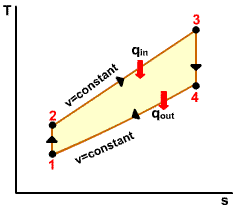 |
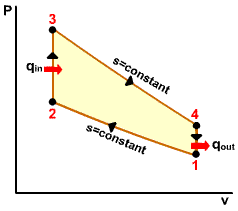 |
Rudolph Diesel (1890)
Very similar to spark-ignition engines, differing mainly in the method of initiating combustion
|
Diesel
Engines
|
Gasoline
Engines
|
| Air is compressed to a temperature which is above the autoignition temperature of the fuel, and combustion starts as the fuel is injected into this hot air | Air-fuel mixture is compressed to a temperature which is below the autoignition temperature of the fuel, and combustion is initiated by firing a spark plug |
|
Process
1-2
|
Isentropic compression | |
|
Process
2-3
|
Constant-pressure heat addition | |
|
Process
3-4
|
Isentropic expansion | |
|
Process
4-1
|
Constant-volume heat rejection |
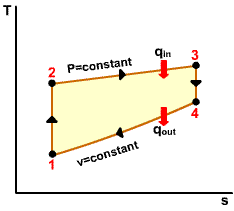 |
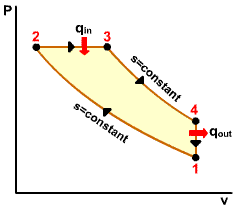 |
George Brayton (1870)
| Open Cycle 1. Fresh air at ambient conditions is drawn into the compressor where its temperature and pressure are raised. 2. The High-pressure air proceeds into the combustion chamber where the fuel is burned at constant pressure. 3. The resulting high-temperature gases enter the turbine where they expand to the atmospheric pressure. |
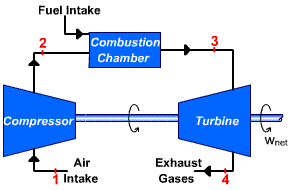 |
|
Process
1-2
|
Isentropic compression | |
|
Process
2-3
|
Constant-pressure heat addition | |
|
Process
3-4
|
Isentropic expansion | |
|
Process
4-1
|
Constant-pressure heat rejection |
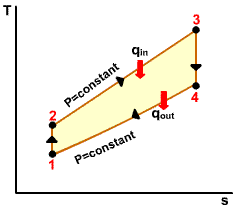 |
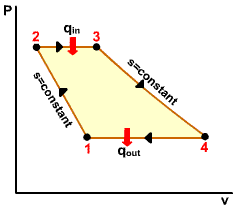 |
The thermal efficiency of the Brayton cycle can be increased as a result
of regeneration since the portion of energy of the exhaust gases that
is normally rejected to the surroundings is now used to preheat the air
entering the combustion chamber.
 |
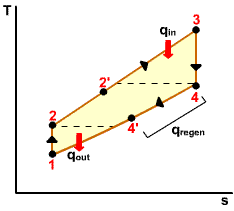 |
The entropy of a pure crystalline substance at absolute zero temperature
is zero since there is no uncertainty about the state of the molecules
at that instant.
absolute entropy